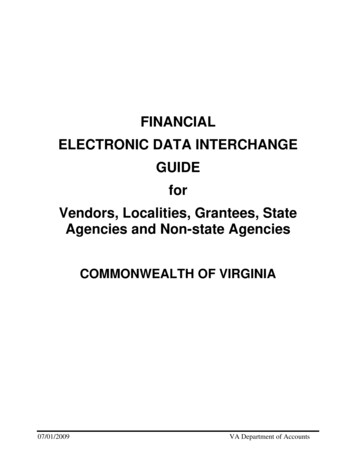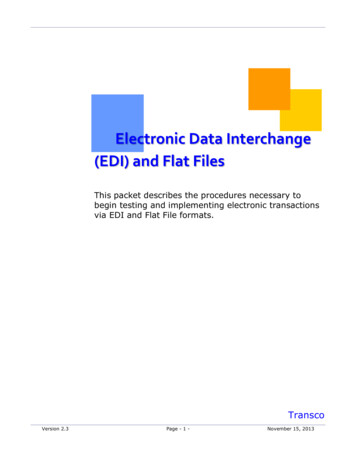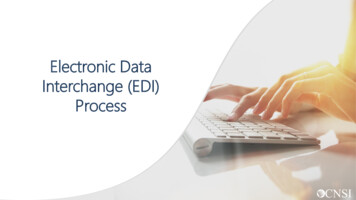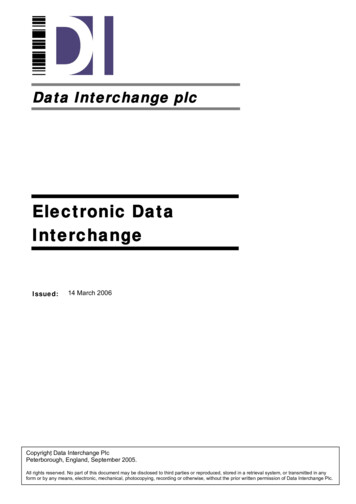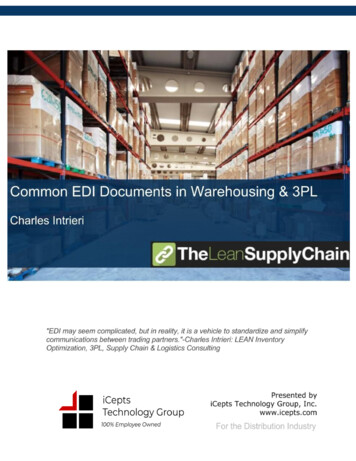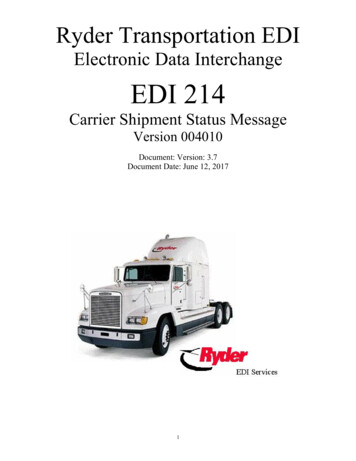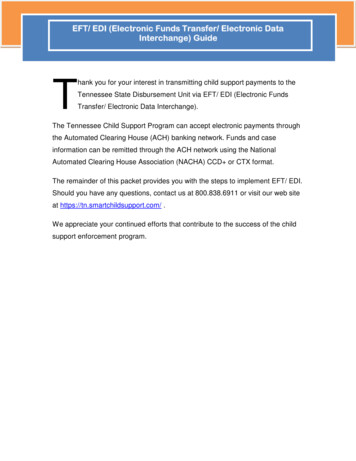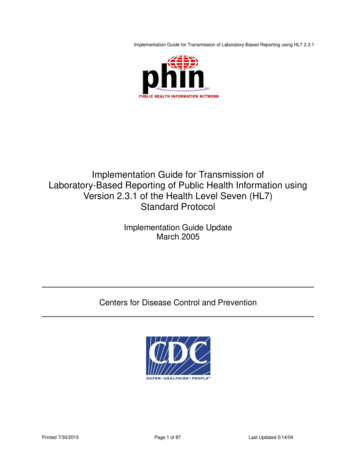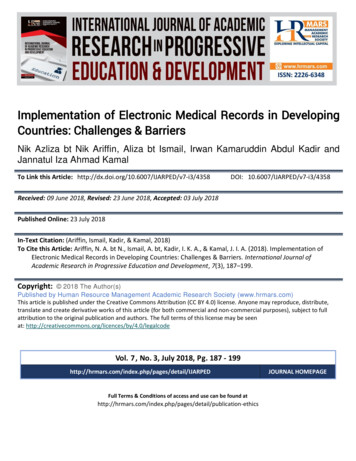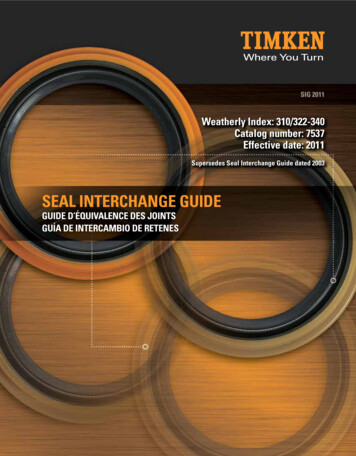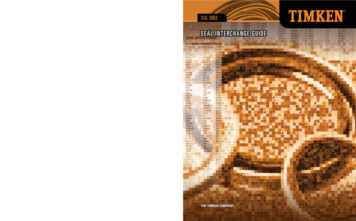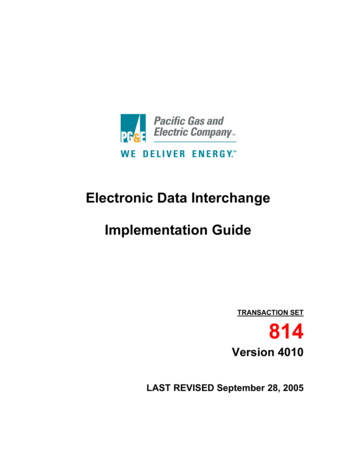
Transcription
Electronic Data InterchangeImplementation GuideTRANSACTION SET814Version 4010LAST REVISED September 28, 2005
version 1.0 July 30, 1999Copyright 1999 by:Pacific Gas & Electric Company77 Beale StreetSan Francisco, CA 94177All rights reserved. No part of this document may be reproduced or copied in any formor by any means -- graphic, electronic, or mechanical, including photocopying, recording,taping, or information and retrieval systems -- without the prior written consent ofPacific Gas & Electric Co.Last Revised 9/28/2005PG&E 814 v.40102
version 1.0 July 30, 1999TABLE OF CONTENTSI. Summary of ChangesII. Setup & Contact InformationIII. IntroductionIV. Best Practices:o Global Best Practiceso Document-Specific Best PracticesV. Table 1 – CMEP to EDI TranslationVI. General Request, Response or Confirmation Transaction SetLast Revised 9/28/2005PG&E 814 v.40103
version 1.0 July 30, 1999Summary of ChangesJuly 30, 1999 Initial Release 814 v.4010.December 1, 1999 Contact information updated (pg. 5).December 17, 1999 Added Interchange Control Structure segments (envelope data): ISA, GS,GE, and IEA.January 12, 2000Changed PG&E Company ContactJanuary 26, 2000Changed Seg N1, Data Element 98, Name 8R Note (Page 22)March 24, 2000May 10, 2000Added REF section in HeaderCorrected segment lengths, pages 5, 10, 20 and 33September 28, 2000 Modified the REF section, the reject reason codes on page 37January 17, 2001Modified the ASI section, add action code 27 on page 30 and add actioncode 24 cancel on page 31. Modified REF section, add 1P/AB/CUSTMVon page 36September 20, 2001 Modified the LIN section, added GAS, Gas Service on page 28. Modifiedthe Note section, on page 33.December 4, 2002 Modified the REF section on page 32. Changed verbiage in REF01 – 06, Page 33change GENID, To XREF.January 14, 2003 Modified the REF – Notes, also changed verbiage to REF 01-06 and REF01-12, on page 32. Modified 76-A76 verbiage on page 36. Modifiedverbiage in REF 06 and REF 12 on page 38. Modified verbiage REF 03352 changed to account reference on page 43.October 28, 2003 Updated REF TZ to indicate alpha character, not numeric on pages 43-44.September 2, 2005 Updated BGN02 segment for minimum/maximum 16 characterrequirement.Last Revised 9/28/2005PG&E 814 v.40104
version 1.0 July 30, 1999PACIFIC GAS AND ELECTRIC SET-UP AND CONTACT INFORMATIONInternet Server File Naming:Inbound File From ESP LDC:ExampleOutbound File From LDC ESP:ExampleESP Short Name CCYY,MM,DD,HH,MM,SSepmi.19990729123400ESP Short Name CCYY,MM,DD,HH,MM,SSepmi.19990730120500Pacific Gas and Electric Communication ID:(ISA Sender ID)Communications ID Qualifier:(ISA Sender ID Qualifier)ESP’s Dun’s Number01ISA Example (ESP LDC): ISA 00 00 01 123456789 01 006912877 990803 1350 U 00401 000000123 0 P ªo Outbound Data Element Delimitero Outbound Data Segment Terminatoro Outbound Data SubElement Separator ª (Hex Value 6A)(Hex Value 5F)(Hex Value A1)Pacific Gas and Electric Company’s Contacts:Travis Graumann(415) 973-7491 (Office)EDISUPPORT@PGE.comRoseann Mott(415) 973-5540EDISUPPORT@PGE.comPacific Gas and Electric Web Site:http://www.pge.comPG&E utilizes ANSI X12 version 004010 following the Utility Industry Guideline (UIG)for 004010. This document is subject to change based upon future UIG approvedstandards and regulatory mandates.Last Revised 9/28/2005PG&E 814 v.40105
814 General Request, Response orConfirmationIntroductionThis document is a subset of a Utility Industry Group (UIG) ImplementationGuideline, which contains the format and establishes the data contents of theElectronic Data Interchange (EDI) General Request, Response or ConfirmationTransaction Set (814). This standard can be used to request actions to beperformed, to respond to a request for actions to be performed, or to confirminformation related to actions performed for or on behalf of Customers. Thecomplete UIG guideline provides additional details on EDI usage.This document represents current usage of transaction set 814 by Californiautilities and is intended to promote a consistent implementation of EDI within theState of California. EDI components appearing in this guide should be accepted bythe transaction receiver even if the receiver does not make use of the information,whereas designation of a component as mandatory, conditional, or optional for atrading partner indicates that the information will be used. Changes should bemade to this guide when changes occur to UIG’s implementation guideline, whenadditional features of UIG’s implementation guideline come into use by Californiautilities, or when the status of utilities’ use of the EDI elements changes.PurposeThis Utility Industry Group (UIG) Implementation Guideline contains the format andestablishes the data contents of the General Request, Response or ConfirmationTransaction Set (814) as adopted by the UIG for use within the context of anElectronic Data Interchange (EDI) environment. This standard can be used torequest actions to be performed, to respond to a request for actions to beperformed, or to confirm information related to actions performed for or on behalf ofCustomers.NotesThis Implementation Guideline was designed to address the business processesthat support the supply of products or services by a third party, such as billpresentment or payment services, warranty services, or alternative energysupply. The primary processes addressed by this Transaction Set 814 are thecustomer request for enrollment with a third party supplier, the maintenance ofcustomer account information, and the dis-enrollment from the third partysupplier.The principal parties involved in this Transaction Set 814 implementation are:oooThe end-use customer (Code 8R)The entity which provides services to the customer on behalf of anotherentity (Code 8S), the UtilityThe entity which has the primary business relationship with the customer(Code SJ), the Energy Service Provider (ESP)When this transaction set is used in an alternative energy supply environment,Code 8S identifies the local distribution utility (LDC or LDC) and Code SJ identifiesthe alternative energy service provider (ESP).07/30/99PG&E 814 v.40106
version 1.0 July 30, 1999814 General Request, Response orConfirmationBest PracticesGlobal Best Practices997 - Functional AcknowledgmentoThe purpose of the 997 is to verify receipt of a transmitted document only, notthe acceptance of the document content. A 997 will be returned to the senderper 814 transaction set, which will indicate compliance with ANSI-X12validation.Interchange Control NumberoA unique and sequential interchange control number should be used on everyenvelope that is transmitted to a trading partner. This approach will allow thereceiver to audit the interchange for any duplicate or missing transmissions.For testing PG&E recommends using a “T” - Test in ISA15.Use of Dun & Bradstreet (DUNS) NumberoDun & Bradstreet assigns a nine-digit identification number to every businessentity. This number, known as the DUNS number, should be used to identifythe trading partners.CapitalizationoThe use of all upper case (capital) letters is mandatory.Time ValueoPG&E transmits all information using the international standard, UniversalCoordinate Time (UTC). UTC, for the purposes of this document, is simply theGreenwich Mean Time (GMT) without daylight savings time correction. UTC isan internationally recognized time representation and is actually used in nearlyall of our modern computer systems, including desktop PCs.oMeter readings, administrative operations, and billing transactions are allreported in UTC. Some account billing is based upon time-of-day which isnormally defined in terms of local time. For those accounts, conversion fromUTC to local time must be performed.oDifferences from UTC to PST is 8 hours, i.e. (480 minutes). PG&E’s serviceterritory local time is based on Pacific Standard Time (PST). The CaliforniaLDC’s have decided not to indicate a specific code in the 814 transaction set.Transaction Set File Leveloo07/30/99Last revised 1/14/03FOLDER LEVEL: Multiple transaction sets can be sent per folder (i.e. 867,814, 810).FILE LEVEL: PG&E recommends one transaction set type (i.e. 814) per file. Inother words, each file will contain a maximum of one transaction set type.PG&E 814 v.40107
version 1.0 July 30, 1999Global Best Practices con’tValid Dataoo07/30/99Last revised 1/14/03PG&E will reject transaction sets that are not ANSI - X12 compliant.PG&E will ignore codes and data content which are not explicitly stated in our814 Implementation Guide.PG&E 814 v.40108
version 1.0 July 30, 1999Document-Specific Best PracticesGeneral UseoooAll items marked with this symbol ( ) are required fields.All items marked with “R” are Recommended fields.All files should be transaction specific (i.e. one file for 814 transactions and aseparate file for other transactions.)Use of the N1 LoopoooIf any one entity performs more than one of the business functions provided inthe N1, the loop should be repeated as necessary to identify that entity as theprovider of those functions.For Account Maintenance transactions when there is a change in the serviceaddress and a Third-Party Customer exists (i.e. one other than the end-useCustomer), this will be represented by code BT in N101.Account Maintenance transactions require a mailing address because theservice address zip code is used for validation.Use of The LIN Segment07/30/99Last revised 1/14/03oIf multiple Consumers are addressed in one 814, a separate LIN loop should beused for each Consumer; i.e., one LIN per Consumer, one Consumer per LIN.When Responding to a Request transaction, the best practice is to identify theLIN segments (LIN01) with the same identification sent in the Request LIN01.oThe UIG recommends that one 814 be limited to one service account for asingle commodity (electric or gas). This single service account may have morethan one meter associated with it, in which case a separate NM1 loop shouldbe used for each meter. The LIN loop contains data relative to a serviceassociated with the service account; e.g., enrollment with an ESP, sign-up forbudget billing, sign-up for direct debit, etc. When Responding to a Requesttransaction, the best practice is to identify the LIN segments (LIN01) with thesame identification sent in the Request LIN01.PG&E 814 v.40109
version 1.0 July 30, 1999Use of the Detail LIN/REF SegmentooooooThree conventions for the Detail LIN/REF segment (position 030) are providedin this implementation guideline, any or all may be used in one transaction:One to convey status reason codes in response to a RequestOne to convey change reason codes in a Request for account maintenanceOne to convey account level reference informationTo allow for multiple rejection reasons when a Request is rejected, the UIGconvention is to transmit the status reasons in the LIN/REF segment (position030) rather than in the ASI03 element, even if there is only one rejectionreason. The codes used in REF02 will be those specified for ASI03; i.e. codesfrom data element 641.The codes used in REF02 when the segment is used for account maintenanceand/or update are maintained by the UIG. The first portion of the codeidentifies the segment that contains the data that has been changed; theremaining portion of the code identifies the relevant code qualifier for the datathat has been changed. The changed data will appear in the appropriateelement of the identified segment.Definitions for Data Elements 128 (REF01), 306 (ASI01), and 875(ASI02)oTo accommodate the identification requirements necessitated by therestructuring of the electric utility industry, the UIG has developed its owndefinitions for the qualifiers and codes found in data elements 128, 306, and875.Acceptance or Rejection at the Account Levelo The UIG recommends that acceptance or rejection of a request should alwaysbe done at the account level. The REF02 codes shown with the REF01 of '7G'at Position 030 in the Detail are provided for that purpose. The codes shownwith the REF01 of '7G' at Position 130 of the Detail are provided for the senderto send additional, meter-level information about the error. Sending informationerror at the meter level is optional; however, rejecting at the meter level canlead to splitting accounts. (See Examples in 814 Tutorial.)07/30/99Last revised 1/14/03PG&E 814 v.401010
version 1.0 July 30, 1999Update TransactionThe Update Transaction is initiated by either the LDC, current ESP, or the pendingESP and is used to communicate changes to service provider / entity relationshipsThe following fields are updated via the UPDATE Transaction:o MDMA (Meter Agent)o MSP (Meter Installer)o Meter Ownero Meter Maintainero Billero Bill Calculatoro Requested start dateo Scheduled start dateo Meter Investigation Statuso Billing Optionso Usage Calculation Code (Meter Request Indicator)o Meter Type Requested (Interval or Load Profile)[Note: Meter investigation status, Usage calculation code, and Meter typerequested are necessary for the switching logic involved. Thus, they are includedin the Update transaction.]Each Update Transaction is to include only those relationships / providers that arechanging. The accepted UPDATE Transaction Response will confirm only thoserequested items with one status and one start date for all relationships.Account Maintenance TransactionsThe Account Maintenance transaction is used to change non-relationship relatedDASR information, i.e. Customer Name, Billing Address, Meter Number, etc. ThisTransaction can be initiated from the LDC, current ESP, or pending ESP. TheAccount Maintenance transaction does not require the other party to make achange. Any Account Maintenance information received from an ESP by PG&E,except that which are explicitly stated below, will be ignored. For a List or AccountMaintenance fields, see CA. Data Dictionary.The following is a list of Acct Maintenance Transactions for which PG&E acceptchanges:o ESP Customer Service Account #)o ESP Rate Schedule07/30/99Last revised 1/14/03PG&E 814 v.401011
TABLE 1CMEP TO EDI TRANSLATIONInitiatedByTrans.IDCMEP TermsEDI /CONNECT (for newaccount onse/Connect - AcceptResponse/Connect - RejectResponse/Connect - 1021Request/DisconnectResponse/Disconnect - AcceptResponse/Disconnect - RejectCompletion Notification/ConnectCompletion nse/Update - AcceptLDC4.311WQ001Response/Update - RejectLDC4.511U001Advance Notification/DisconnectLDC1.5147002Advance 5.1137001Response/Update – AcceptLDC5.311WQ001Response/Update – RejectLDC5.411U001Completion Notification/ConnectLDC5.5CNF001Request/Account MaintenanceResponse/Account Maintenance- AcceptResponse/Account Maintenance- 4WQ022147001SVC/DISCONNECTSP-REQ/UPDATE(pending relationship)SP-ACK/UPDATE(pending relationship)SP-NAK/UPDATE(pending relationship)CFG/UPDATE (PriorDisconnect Notice Former Departing)CFG/UPDATE (PendingConnect)SP-REQ/UPDATE(existing relationship)SP-ACK/UPDATE(existing relationship)SP-NAK/UPDATE(existing relationship)CFG/UPDATE AK/MAINTCFG/MAINTCFG/UPDATE07/30/99PG&E 814 v.4010LDCBGN ASI01 ASI0212
814 General Request, Response or ConfirmationGEFunctional Group ID Introduction:This Draft Standard for Trial Use contains the format and establishes the data contents of the General Request,Response or Confirmation Transaction Set (814) for use within the context of an Electronic Data Interchange (EDI)environment. This standard can be used to request actions to be performed, to respond to a request for actions to beperformed or to confirm information related to actions performed.Interchange Control rchange Control HeaderFunctional Group STNameTransaction Set HeaderReq.Des.MMax.Use120020BGNBeginning SegmentMLoopRepeatNotes andCommentsLoopRepeatNotes andCommentsHeader:1LOOP ID - N1 122040N1NameO124050N2Additional Name InformationO225060N3Address InformationO226070N4Geographic LocationM127080PERAdministrative Communications ContactO 128090REFReference IdentificationO OOP ID - LINNotes andComments 129010LINItem IdentificationO131020ASIAction or Status IndicatorO133030REFReference IdentificationO 141040DTMDate/Time ReferenceO 142080NM1Individual or Organizational NameO143130REFReference IdentificationO 1LOOP ID - NM107/30/99LoopRepeat 1PG&E 814 v.4010n213
version 1.0 July 30, ETransaction Set TrailerMMax.UseLoopRepeatNotes andCommentsLoopRepeatNotes andComments1Interchange Control ctional Group TrailerInterchange Control TrailerReq.Des.MMMax.Use11Transaction Set Notes1.2.The N1 loop is used to identify the transaction sender and receiver.The NM1 loop is used to identify the parties associated with the individual line item (LIN), such as anindividual consumer in a consolidated third party Consumer Service Provider transaction.07/30/99Last revised 1/14/03PG&E 814 v.401014
version 1.0 July 30, 1999Segment:Position:Loop:Level:Usage:Max Use:Purpose:Syntax Notes:Semantic A04MISA05MISA06MISA07MISA08MISA0907/30/99Last revised 1/14/03ISA Interchange Control Header010Mandatory1To start and identify an interchange of zero or more functional groups and interchangerelated control segmentsEx: ISA 00 00 01 043000261 ZZ 00691287702B 991015 0823 U 00401 000000333 0 P ªData Element SummaryDataElement NameAttributesI01Authorization Information QualifierM ID 2/2Code to identify the type of information in the Authorization InformationNo Authorization Information Present (No Meaningful00Information in I02)I02Authorization InformationM AN 10/10Information used for additional identification or authorization of theinterchange sender or the data in the interchange; the type of information is setby the Authorization Information Qualifier (I01)I03Security Information QualifierM ID 2/2Code to identify the type of information in the Security Information00No Security Information Present (No MeaningfulInformation in I04)I04Security InformationM AN 10/10This is used for identifying the security information about the interchangesender or the data in the interchange; the type of information is set by theSecurity Information Qualifier (I03)I05Interchange ID QualifierM ID 2/2Qualifier to designate the system/method of code structure used to designatethe sender or receiver ID element being qualified01Duns (Dun & Bradstreet)I06Interchange Sender IDM AN 15/15Identification code published by the sender for other parties to use as thereceiver ID to route data to them; the sender always codes this value in thesender ID elementI05Interchange ID QualifierM ID 2/2Qualifier to designate the system/method of code structure used to designatethe sender or receiver ID element being qualifiedZZMutually DefinedI07Interchange Receiver IDM AN 15/15Identification code published by the receiver of the data; When sending, it isused by the sender as their sending ID, thus other parties sending to them willuse this as a receiving ID to route data to themI08Interchange DateM DT 6/6Date of the interchangePG&E 814 v.401015
version 1.0 July 30, ISA15I14MISA16I1507/30/99Last revised 1/14/03Interchange TimeM TM
Electronic Data Interchange (EDI) environment. This standard can be used to request actions to be performed, to respond to a request for actions to be performed, or to confirm information related to actions performed for or on behalf of Customers. Notes . This Implementation
